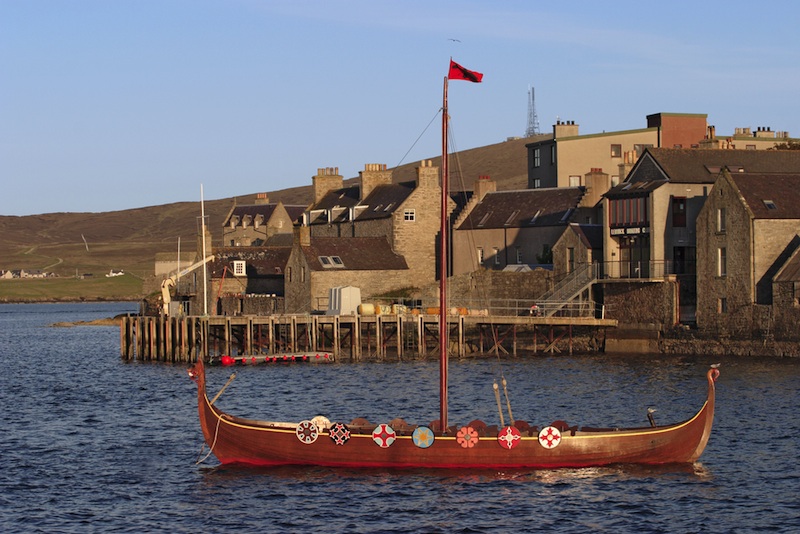
Vikings may have been family men who traveled with their wives to new lands, according to a new study of ancient Viking DNA.
Maternal DNA from ancient Norsemen closely matches that of modern-day people in the North Atlantic isles, particularly from the Orkney and Shetland Islands.
The findings suggest that both Viking men and women sailed on the ships to colonize new lands. The new study also challenges the popular conception of Vikings as glorified hoodlums with impressive seafaring skills. [Fierce Fighters: 7 Secrets of Viking Men]
"It overthrows this 19th century idea that the Vikings were just raiders and pillagers," said study co-author Erika Hagelberg, an evolutionary biologist at the University of Oslo in Norway. "They established settlements and grew crops, and trade was very, very important."
Vikings hold a special place in folklore as manly warriors who terrorized the coasts of France, England and Germany for three centuries. But the Vikings were much more than pirates and pillagers. They established far-flung trade routes, reached the shores of present-day America, settled in new lands and even founded the modern city of Dublin, which was called Dyfflin by the Vikings.
Some earlier genetic studies have suggested that Viking males traveled alone and then brought local women along when they settled in a new location. For instance, a 2001 study published in the American Journal of Human Genetics suggested that Norse men brought Gaelic women over when they colonized Iceland.
Modern roots
Get the world’s most fascinating discoveries delivered straight to your inbox.
To learn more about Norse colonization patterns, Hagelberg and her colleagues extracted teeth and shaved off small wedges of long bones from 45 Norse skeletons that were dated to between A.D. 796 and A.D. 1066. The skeletons were first unearthed in various locations around Norway and are now housed in the Schreiner Collection at the University of Oslo.
The team looked at DNA carried in the mitochondria, the energy powerhouses of the cell. Because mitochondria are housed in the cytoplasm of a woman's egg, they are passed on from a woman to her children and can therefore reveal maternal lineage. The team compared that material with mitochondrial DNA from 5,191 people from across Europe, as well as with previously analyzed samples from 68 ancient Icelanders.
The ancient Norse and Icelandic genetic material closely matched the maternal DNA in modern North Atlantic people, such as Swedes, Scots and the English. But the ancient Norse seemed most closely related to people from Orkney and Shetland Islands, Scottish isles that are quite close to Scandinavia.
Mixed group
"It looks like women were a more significant part of the colonization process compared to what was believed earlier," said Jan Bill, an archaeologist and the curator of the Viking burial ship collection at the Museum of Cultural History, a part of the University of Oslo.
That lines up with historical documents, which suggest that Norse men, women and children — but also Scottish, British and Irish families — colonized far-flung islands such as Iceland, Bill told Live Science. Bill was not involved with the new study.
"This picture that we have of Viking raiding — a band of long ships plundering — there obviously would not be families on that kind of ship," Bill said. "But when these raiding activities started to become a more permanent thing, then at some point you may actually see families are traveling along and staying in the camps."
As a follow-up, the team would like to compare ancient Norse DNA to ancient DNA from Britain, Scotland and the North Atlantic Isles, to get a better look at exactly how all these people are related, Hagelberg said.
The findings were published today (Dec. 7) in the journal Philosophical Transactions of the Royal Society B.
Follow Tia Ghose on Twitterand Google+. Follow Live Science @livescience, Facebook & Google+. Originally published on Live Science.

Tia is the editor-in-chief (premium) and was formerly managing editor and senior writer for Live Science. Her work has appeared in Scientific American, Wired.com, Science News and other outlets. She holds a master's degree in bioengineering from the University of Washington, a graduate certificate in science writing from UC Santa Cruz and a bachelor's degree in mechanical engineering from the University of Texas at Austin. Tia was part of a team at the Milwaukee Journal Sentinel that published the Empty Cradles series on preterm births, which won multiple awards, including the 2012 Casey Medal for Meritorious Journalism.


